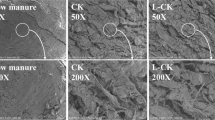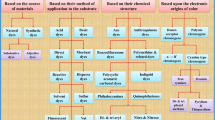Abstract
Immobilized forms of two marine cyanobacteria, Oscillatoria sp. NTMS01 and Phormidium sp. NTMS02, were selected for the removal of chromium (VI) ions from an aqueous solution. Biosorption was studied as a function of pH (1–6), contact time (5–180 min) and initial chromium concentration (1–3 mg/L) to compare the maximum capacity of two immobilized marine cyanobacteria. These organisms were found to be efficient sorbents for the removal of chromium (VI) ions in lower concentrations. Biosorption equilibrium was established in about 30 min. Maximum adsorption was observed at pH 3. The biosorption was performed as described in terms of Langmuir and Freundlich isotherms. These organisms were found to fit better by the Freundlich isotherm, which indicated heterogeneity of the algal surface.




Similar content being viewed by others
References
Anjana K, Kaushik A, Kiran B, Nisha R (2007) Biosorption of Cr (VI) by immobilized biomass of two indigenous strains of cyanobacteria isolated from metal contaminated soil. J Hazard Mater 148:383–386
Awasthi M, Rai LC (2004) Adsorption of nickel, zinc and cadmium by immobilized green algae and cyanobacteria: a comparative study. Ann Microbiol 54(3):257–267
Clesceri LS, Greenberg AE, Trussell RR (1996) Standard methods for the examination of water and wastewater. APHA, AWWA and WPCF, Washington DC
Congeevaram S, Dhanarani S, Park J, Dexilin M, Thamaraiselvi K (2007) Biosorption of Chromium and Nickel by heavy metal resistant fungal and bacterial isolates. J Hazard Mater 146:270–277
Crist HR, Oberholser K, Shank N (1981) Nature of bonding between metallic ions and algal cellwalls. Environ Sci Technol 15:1212–1217
Donmez G, Aksu Z (2002) Removal of chromium (VI) from saline wastewaters by Dunaliella species. Process Biochem 38(5):751–762
Freundlich H, Helle WJ (1939) Rubber die adsorption in Lusungen. J Am Chem Soc 61:2–28
Friis N, Myers-Keith P (1986) Biosorption of uranium and lead by Streptomyces longwoodensis. Biotechnol Bioeng 28:21–28
Galun M, Galun E, Siegel BZ, Keller PE, Lehr H, Siegel SM (1987) Removal of metal ions from aqueous solutions by Penicillum biomass: kinetic and uptake parameters. Water Air Soil Pollut 33:359–371
Katircioglu H, Aslim B, Turker AR, Atici T, Beyatli Y (2008) Removal of cadmium (II) ion from aqueous system by dry biomass, immobilized live and heat-inactivated Oscillatoria sp. H1 isolated from freshwater (Mogan Lake). Bioresour Technol 99:4185–4191
Khummongkol D, Canterford GS, Freyer C (1982) Accumulation of heavy metals in unicellular algae. Biotechnol Bioeng 12:2643–2660
Kumar MS, Muralitharan G, Thajuddin N (2009) Screening of a hypersaline cyanobacterium, Phormidium tenue, for the degradation of aromatic hydrocarbons: naphthalene and anthracene. Biotechnol letters 31(12):1863–1866
Leusch A, Holan ZR, Volesky B (1995) Biosorption of heavy metals (Cd, Cu, Ni, Pb, and Zn) by chemically-reinforced biomass of marine algae. J Chem Technol Biotechnol 62:279–288
Li S, Jin-lan X, Hua HE, Zhen-Yuan N, Guan-zhou Q (2007) Biosorption mechanism of Cr (VI) onto cells of Synechococcus sp. J Cent South Uni Technol, 02-0157-06
Manriquez RA, Magana PI, Lopez V, Guzman R (1997) Biosorption of Cu by Thiobacillus ferrooxidans. Bioprocess Eng 18:113–118
Manzini G, Ceesaro A, Delbin F, Paoletti S, Reisenhofer E (1984) Copper (II) binding by natural ionic polysaccharides. Part I, potentiometeric and spectroscopic data. Bioelectrochem Bioeng 12:443–454
Nurba M, Nourbakshsh S, Kilicarslan S (2002) Biosorption of Cr6+, Pb2+ and Cu2+ ions in industrial waste water on Bacillus sp. J Chem Eng 85(2/3):351–355
Ozer A, Ozer D (2003) Comparative study of the biosorption of Pb (II), Ni (II) and Cr (VI) ions onto S. cerevisiae: Determination of biosorption heats J. J Hazard Mater 100(1/3):219–229
Paknikar KM, Pethkar AV, Puranik PR (2003) Bioremediation of metalliferous wastes and products using inactivated microbial biomass. Indian J Biotechnol 2:426–443
Pardo R, Herguedas M, Barrado E, Vega M (2003) Biosorption of cadmium, copper, lead and zinc by inactive biomass of P. putida. Anal Bioanal Chem 376:26–32
Ramelow GJ, Fralick D, Zhao Y (1992) Factors affecting the uptake of aqueous metal ions by dried seaweed biomass. Microbiology 72:81–93
Roy D, Greenlaw PN, Shane BS (1993) Adsorption of heavy metals by green algae and ground rice hulls. J Environ Sci Health 28:37–50
Selvaraj K, Manonmani S, Pattabi S (2003) Removal of hexavalent chromium using distillery sludge. Bioresour Technol 89:207–211
Subramanian G, Uma L (1996) Cyanobacteria in pollution control. J Sci Ind Res 55:685–692
Sudha SR, Abraham TE (2001) Biosorption of Cr (VI) from aqueous solution by Rhizopus nigricans J. Bioresour Technol 79(1):73–81
Tsezos M, Volesky B (1982a) The Mechanism of uranium biosorption by Rhizopus arrhizus. Biotechnol Bioeng 24:385–401
Tsezos M, Volesky B (1982b) The Mechanism of thorium biosorption by Rhizopus arrhizus. Biotechnol Bioeng 24:955–969
Veglio F, Beolchini F (1997) Removal of metals by biosorption: a review. Hydrometallurgy 44:301–316
Viraraghavan T, Yan GY (2001) Heavy metal removal in a biosorption column by immobilized M. rouxii biomass. Bioresour Technol 78:243–249
Volesky B (1994) Advances in biosorption of metals: Selection of biomasss types. FEMS Microbiol Rev 14:291–302
Volesky B (2001) Detoxification of metal-bearing effluents: biosorption for the next century. Hydrometallurgy 59:203–216
Wang JL, Chen C (2006) Biosorption of heavy metals by Saccharomyces cerevisiae; a review. Biotechnol Adv 24:427–451
Xue HB, Sigg L (1990) The binding of heavy metals to algal surfaces. Water Res 22:917–926
Acknowledgments
This investigation was supported by the Ministry of Earth Sciences (MoES), Government of India. M.S. acknowledges the award of UGC–Rajiv Gandhi National Fellowship (RGNF).
Author information
Authors and Affiliations
Corresponding author
Rights and permissions
About this article
Cite this article
Rajeshwari, K., Kumar, M.S. & Thajuddin, N. Adsorption isotherms for Cr (VI) by two immobilized marine cyanobacteria. Ann Microbiol 62, 241–246 (2012). https://doi.org/10.1007/s13213-011-0252-3
Received:
Accepted:
Published:
Issue Date:
DOI: https://doi.org/10.1007/s13213-011-0252-3




